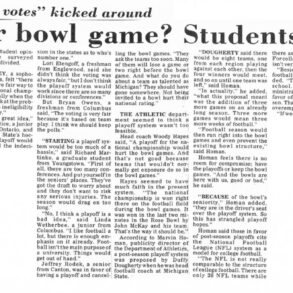
The English Premier League entered the final day of its season with a unique kind of drama that might soon make its way to college football.
First place had been decided a month ago, and the group of clubs being relegated to the second-tier league had already been set. Last Saturday’s intrigue concerned who would qualify for the Champions League, with five teams battling for three unclaimed spots.
Advertisement
Stakes like this could be the future of college football if Big Ten commissioner Tony Petitti gets his wish.
A few years ago, I spoke with The Athletic’s European soccer writers about how college football was more similar to their sport than to the NFL. It remains true today. Teams don’t draft players; they recruit and sign them. Big teams take players from small teams. Teams are rooted specifically in their community and can’t relocate. And rumblings about a Super League face pushback as the sport’s richest and most powerful organizations solidify their place at the top without a formal breakaway from the current structure.
The similarity between the two sports might soon include the championship tournament. When colleague Stewart Mandel notes that no major American sport guarantees more automatic playoff spots to certain groups than college football, he’s right. But the emphasis is on American.
The UEFA Champions League, which will hold its final on Saturday when Inter Milan takes on Paris Saint-Germain in Munich, gives out an uneven number of automatic bids to each country’s domestic league. There will be 82 teams across 53 European countries in next year’s tournament. The top five leagues are guaranteed four spots. The sixth league gets three, the seventh- through 15th-ranked leagues get two, and everyone else gets one.
The ranking of those soccer leagues is determined by a formula that calculates how well teams from that league performed in the previous season’s European competitions, and the bids handed out to each country are determined by domestic league standings.
This is essentially what the Big Ten has proposed (and the SEC hasn’t yet pushed back on) for the next round of College Football Playoff expansion, just with fewer leagues and the bid allotments locked in for conferences. The proposed “4-4-2-2” split of automatic qualifiers (AQs) among the Power 4 does roughly mirror the leagues’ past decade of Playoff participation.
Advertisement
“The idea that (soccer leagues) understand, they don’t have a committee determining that,” Florida athletic director Scott Stricklin said this week. “They’ve been able to objectively, through results and their standings, allot those opportunities. I think there’s something there that we can learn from, and that’s what the AQ conversation ties back to.”
Whether you like anything about this idea is a separate question, but the Big Ten’s CFP idea is rooted partly in what happens across the pond.
Driving the plan is the idea that the regular-season standings will determine who makes the field, rather than a human committee. In particular, the SEC has publicly questioned the CFP committee, even though the SEC and Big Ten have garnered far more bids from that group than other leagues.
There are some obvious differences between the models. Champions League rounds are played throughout the domestic leagues’ regular season, featuring clubs that qualified the previous year but may bring dramatically different rosters into the tournament. College football’s tournament takes place immediately following the regular season.
Even the concept of a play-in tournament, which the Big Ten and SEC have considered setting up on conference championship weekend and selling to a broadcaster for more TV money, has a parallel in Europe.
In England’s second-tier league, the first- and second-place teams are guaranteed promotion to the Premier League. Teams No. 3 through 6 have a playoff to determine who gets the last spot. A top-six finish in the regular season gives you a chance to reach promotion. Other countries and tiers have similar formats.
Under the Big Ten’s idea, an Iowa team that went 8-4 in the regular season last year with no AP Top 25 wins would have a shot at the Playoff because it finished in sixth place in the conference.
Advertisement
While the Champions League has the most-watched sports final in the world, it, too, isn’t immune to the demands of the richest teams. It has made constant tweaks and just last year added two more at-large spots for the top two leagues, another measure to stave off a breakaway Super League.
As a result, England got five auto-bids this year rather than four. (The EPL got six because Tottenham Hotspur won the Europa League, which is the equivalent of European soccer’s NIT and provides a Champions League automatic bid to the winner.)
However, unlike college sports, fans of European soccer hold more power through protest. The Super League proposed in 2021 would’ve supplanted the Champions League with a tournament that guaranteed spots for 15 of the most prestigious soccer teams and some additional at-large spots.
But it was the fans of those teams, particularly in England, who revolted against the idea. The supporters who would’ve seen more big international games and more TV money for their high-profile clubs instead took to the streets, put up banners on their stadiums and rallied against the idea.
As much as money had taken over the sport, it couldn’t excuse a completely naked cash grab. The allure of regionality and concern over domestic league ramifications still meant something. Players and government officials also spoke out against the idea, and the Super League collapsed as teams bowed to the pressure.
That hasn’t happened in America. College sports fans have been blindsided by various conference realignment moves, seeing century-old rivalries disappear or teams get left behind. Many fans are not fully happy with the resulting new order, even some of those who have landed in a more financially valuable conference. Some politicians have spoken out, but none have done anything yet.
Now, fans will likely have to prepare for four different CFP formats in four years, including a move to straight seeding for 2025, before whatever the 2026 format turns out to be.
Advertisement
No college sport or major American sport guarantees multiple bids to a division (or conference) in its postseason. But the biggest sports tournament in the world does. The two most powerful conferences might soon try to force through a model that looks unfair to many college football diehards but sounds awfully familiar to international soccer fans.
— The Athletic’s Seth Emerson contributed reporting.
(Photo: Richard Heathcote / Getty Images)
This post was originally published on this site be sure to check out more of their content.










